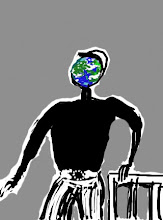I've been thinking about location and Dickens' Martin Chuzzlewit, in part because it is the only one of Dickens’s major novels to have extended scenes set in non-European
locations (indeed: among the shorter fiction, I think only the novella Perils of Certain English Prisoners
(1857) and the play he wrote with Collins, The
Frozen Deep (1857)—minor works, both—venture beyond European settings). The simple reason for this is that Dickens
preferred to extrapolate from his own first-hand experience, and the only non-European
place to which he himself had travelled was America. But of course his novels apprehend the non-European
world; as a writer with synoptic ambition writing in the heyday of the British
empire could hardly fail to do; and he actively advocated emigration,
especially to Australia, for the British poor.
The way Dickens’s novels represent the lands of beyond-Europe, though,
is marginal: Walter Gay is set away to
the West Indies on company business in Dombey
and Son, but whatever happens to him there happens offstage and is only of
interest insofar as it affects affairs in Britain. David
Copperfield packs a number of its characters off to the antipodes by way of
arranging their happy endings, but no scenes in the novel are set there. Arthur Clenham is back from China at the
beginning of Little Dorrit, although
the furthest afield the novel itself travels is the south of France.
Martin
Chuzzlewit,
then, is unusual in moving its protagonist thousands, rather than hundreds, of
miles from home. But it is also unusual
in the way it triangulates, as it were, the London-Salisbury axis of its main
events in global terms. The three apexes
of this triangle are: the USA, India—Bengal, where Tigg’s supposed property in
part underwrites the viability of the Anglo-Bengalee Assurance company—and Tasmania
(the Van Dieman’s Land to which Moddle flees rather than marry the forbidding
Miss Pecksniff). Now what is interesting
about the last two of these three locations is that they don’t, really, exist. To be precise: of course Bengal and Tasmania
exist, and existed in the 1840s as tangible imperial destinations. But in terms of the novel, Bengal is a
fraudster’s fiction, and Van Dieman’s Land is an anti-place, defined only in terms
of being as far from his fiancée as possible, a kind of second-best to suicidal
annihilation (the comedy of Moddle’s note is beautifully judged: ‘Frequently—when
you have sought to soothe my brow with kisses—has self-destruction flashed
across me. Frequently—incredible as it may seem—have I abandoned the idea.’) Then there is America. It might seem absurd to argue that the USA in
Chuzzlewit doesn’t exist: it is not
only an actual place, it is described in a great deal of detail, and with much
of the brilliant clutter of Dickens’s London.
Some critics might concur with P N Firbank’s ‘certainty’ that the American
scenes represent a kind of attenuation of the proper Dickensian mode (‘certainly
the American chapters strike us as generally thinner and more extravagant than
the rest of the novel’ because American society itself was ‘much looser and thinner
in texture’; Firbank, Martin Chuzzlewit
[Penguin 1968], 25). But there
are many others who find the American scenes thick with life and laughter, for
all that the tone is more bitingly satirical.
Rather, I am talking about what Rodney Stenning Edgecombe calls ‘topographical
disaffection’ in the novel. Edgecombe’s
analysis takes as its starting point Robert
Lawson-Peebles analysis of the relationship between Dickens’s letters from
America, American Notes and Chuzzlewit itself:
As Edgecombe notes, Lawson-Peebles
makes
some interesting discoveries—transpositions and conflations of the landscape—and
is led to the following conclusion: "Previous analyses of Dickens's
revulsion against America, then, identify the causes either within American
society, or within the novelist's psyche. I would like to propose a third
possible cause: the American terrain. The process of revulsion, I suggest, was
reinforced as Dickens went westwards into the American hinterland. These new
experiences provided him with a language which (so to speak) brought into full
bloom an anti-pastoral element which had already taken root in his
fiction." [Robert Lawson-Peebles, ‘Dickens Goes West’, quoted in Rodney
Stenning Edgecombe, ‘Topographic Disaffection in Dickens's American Notes and Martin
Chuzzlewit’, The Journal of English
and Germanic Philology 93 (1994), 37]
What Dickens revolted against, the argument goes, is that (as
Edgecombe puts it) ‘the shortcomings of American society were there for the
noting, the psyche of a disappointed republican received the data, and the
neutral American landscape, like a Rorschach Blot, obligingly configured with
the revulsions and disappointments that filtered its perceptions.’ In American
Notes Dickens touches on a kind of anti-sublime, a sublime of decay: ‘In so vast a country, where there are thousands
of millions of acres of land yet unsettled and uncleared, and on every road of
which, vegetable decomposition is annually taking place; where there are so
many great rivers, and such opposite varieties of climate.’
Dickens
had not seen the deserts of the West, but he had at least seen a prairie, and
no doubt had some theoretic sense of its typicality. And yet here, in the
closing pages [of American Notes] he
projects America—its varieties of climate notwithstanding—as a vast swampy
forest, unwholesome and endlessly rotting. [Edgecombe 38]

No comments:
Post a Comment